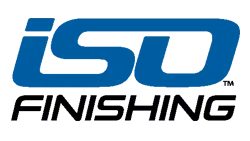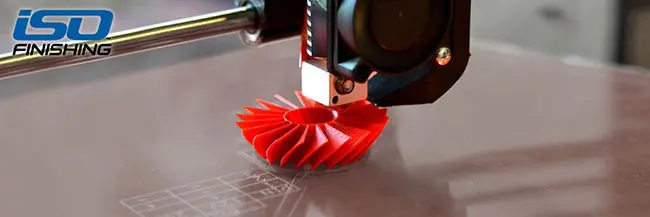Additive manufacturing (AM) refers to the use of special technology to build 3D objects by adding or fusing several layers of material on top of one another. While AM alone can cover component construction, most parts need to be deburred and polished to make a finished product.
ISO Finishing supports a variety of surface finishing techniques for prototype and production processes within additive manufacturing:
- SLS (selective laser sintering)
- FDM (fused deposition modeling)
- SL (stereolithography)
- DMLS (direct metal laser sintering)
- MJM (multi-jet modeling)
Industries Where Additive Manufacturing is Unstoppable
As additive manufacturing technologies have advanced, 3D printing is moving outside the R&D arena and onto the production line. These processes are developing and producing concepts previously unattainable in the manufacturing world.
Smaller specialized manufacturers to Fortune 500 companies and large OEM’s have embraced the advanced enterprise of 3D printing to meet their tough performance standards and requirements. As companies have designed for additive manufacturing and utilized it as a compliment to traditional manufacturing, new applications have come to the scene and changed what’s possible.
The advantages of Additive Manufacturing really start from its high flexibility due to the product being produced directly from a CAD model without the need for tooling. This also allows the process to produce virtually any geometry that can be designed. There are four industries in particular where the amazing capabilities of additive manufacturing have transformed production:
Aerospace
Applications in aerospace, for example the fuel nozzles for a high-bypass turbofan jet engine, highlight the possibilities of Additive Manufacturing in this demanding industry. Additive Manufacturing allowed engineers to design a fuel nozzle which is much lighter and extremely more durable than the previous part.
Additive Manufacturing bolsters the vast group of production processes, allowing designers and engineers to improve existing process chains, as well as offering new opportunities for production.
Dental
There are some applications, for example dental restorations, that really tap the full potential of this process. In this highly individualized production process it is economically viable to use these technologies, speeding up the production time without inflating the costs per part. Being able to provide cost effective products to the end customer is extremely important.
Firearms
The firearms industry also benefits from additive manufacturing. Since this process is a seemingly no-waste process, many metallics are cost effective. Titanium and steel are the most widely used metals in the firearm industry. Lead times with additive manufacturing allow firearm manufacturers to reduce market launch time to weeks or months compared to months and years. Multiple versions of a design can be 3D printed at once allowing version testing and/or customer production to be completed in just days.
Medical
There is also a greater opportunity for additive manufacturing applications in the medical industry. More specifically in the orthopedics segment. It expected to grow as the single largest area of medical additive manufacturing. Production of all additive manufactured orthopedic and medical implants is the fastest growing segments focusing on components of knee reconstruction systems, spinal fusion devices, and non-load-bearing extremity fracture devices. Additive Manufacturing is solving many present-day challenges with these medical device implants: even though no human body is exactly like another, implants must fit perfectly and be quickly tolerated by the body. These implants must be tailor-fitted to the patient. Patient-specific parts can be generated without using tools, using high-quality, medically compatible materials. Lattice structures can help to accelerate post-operative healing significantly, and provides fast availability at a reasonable price.
Benefits of Additive Manufacturing
Cost Variables
The cost per unit (CPU) depends primarily on material, along with build time, determined by the complexity of the geometry. In short, in some cases it’s cheaper to make an intricate design rather than a solid block of material in the same space. Less material, less cost.
Design Flexibility
Additive layering allows developers greater freedom in design. While traditional manufacturing techniques can dominate—and frequently limit—the product development process, AM is more free-form and poses very few restrictions.
Faster Manufacturing Cycle Time
In its early stages, additive manufacturing made headlines for its speed and efficiency to produce a single working model. Rapid prototyping has since evolved into a much larger scale, mass-producing products almost as quickly as their CNC machined counterparts.
Additive Manufacturing Materials
Engineers and other professionals use a variety of materials for additive manufactured products. Common materials include
Ceramics
- Porcelain
- Glass
- Metal oxides
- CMC’s (ceramic matrix composites)
Metals
- Carbon steel
- Stainless steel
- Titanium
- Precious metals
- Aluminum
- Exotic alloys
- The Broader Context
Polymers
- Acrylonitrile butadiene styrene (ABS)
- Polylactic acid (PLA)
- Polyvinyl alcohol (PVA)
- Polycarbonate
While 3-D printers—which fall under the broad umbrella of AM—have garnered most of the industry’s attention in recent years. 3-D technology has morphed from a prototype luxury in the 80’s into a medium to large scale production workhorse used in today’s diverse manufacturing mix. As patents continue to expire and more competitors enter the market the 3D industry is well positioned for dramatic growth.
The need for speed, flexibility and scalability in the medical, performance motorsports, aerospace and other high-tech industries has driven many of the developmental milestones achieved in 3D technology. Hybridizing the performance traits of CNC machining and injection molding with those of 3D printing is providing designers, engineers and manufacturers with limitless options.
Support Removal Mass Finishing Services
In order to achieve the necessary specifications or improve properties such as surface quality, geometrical accuracy and mechanical properties, it is often necessary to post-process and finish components produced with Additive Manufacturing techniques.
There is usual surface roughness left on parts after the support structural material is removed. Most physical characteristics can be enhanced by adding well developed and documented surface finishing processes at the end of the AM process chain. The high quality of metal products produced using AM processes enables the use of many metal-machining finishes to meet the requirements of surface quality and geometry. Following removal of support structures to separate the parts from the build platform, the products can be milled, drilled, polished, etc.
Our team designs, tests, and refines a unique finishing process for every product we work with. Each set of parameters is assigned a controlled test report identification number for reference and subsequent processing. Depending on a part’s material, geometry, and purpose, our parameters may include vibratory deburring/polishing, centrifugal barrel polishing, ultrasonic cleaning, passivation, anodizing or other coating services—but there is far more to success than a plan.
Using cutting-edge technology, we execute our work with extreme precision, attention to detail, and client-driven goals. Our professionals and equipment are consistently up-to-date with the latest advancements in science and engineering, driving continuous improvement in our processing and outputs. To explore our capabilities, visit our Services, and Equipment & Supplies pages.
ISO Finishing works on products made of all types of materials. Contact us today at 1-844-623-7998 for creating surface perfection on your additive manufactured parts.


